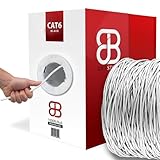All Categories







DRIPSTONE CAT6 1000ft 23AWG 550Mhz Solid UTP Ethernet Cable RJ45 CCA Bulk Network LAN Wire RJ45 Easy Pull Box 305M (Black)
Share Tweet
Get it between 2025-03-13 to 2025-03-20. Additional 3 business days for provincial shipping.
*Price and Stocks may change without prior notice
*Packaging of actual item may differ from photo shown
- Electrical items MAY be 110 volts.
- 7 Day Return Policy
- All products are genuine and original








DRIPSTONE CAT6 1000ft 23AWG 550Mhz Solid UTP Features
-
Data Transfer Rate: CAT6 cables are designed to support data transfer rates of up to 10 Gbps (gigabits per second). This makes them suitable for high-speed networks, including Gigabit Ethernet and some 10 Gigabit Ethernet installations.
-
Crosstalk Reduction: CAT6 cables are constructed with tighter twists in the cable pairs and often feature additional insulation to reduce crosstalk, which is electromagnetic interference between adjacent pairs of wires. This results in improved signal quality and less data loss.
-
Backward Compatibility: CAT6 cables are backward compatible with older Ethernet standards such as Cat5 and Cat5e. You can use CAT6 cables in networks that use these older standards, but the performance will be limited to the capabilities of the lowest-rated component.
-
Connector Type: CAT6 cables typically use RJ-45 connectors, the standard connector for Ethernet connections. These connectors have eight pins and are used for both CAT6 and older Ethernet cables.
-
Wire Gauge: CAT6 cables use 23 AWG (American Wire Gauge) conductors, which are thicker than the 24 AWG conductors used in Cat5e cables. This larger wire gauge helps reduce signal attenuation over longer cable runs.
-
Maximum Cable Length: The maximum recommended length for out CAT6 cable is 100 meters (328 feet) when used for 10/100/1000BASE-T Ethernet
-
Cable Construction: 23AWG UTP (Unshielded Twisted Pair Wire) CCA Conductor (Copper Clad Aluminum) with new PVC (Polyvinyl Chloride) outer jacket. Inside twisted pairs insulation consists of polyethylene (PE) coating
-
Sequential Length Markings: Running "FT" count printed on cable makes measuring easy. These markings are printed every 2 feet, and they start from one end of the cable and count up as you unroll the wire
About DRIPSTONE CAT6 1000ft 23AWG 550Mhz Solid UTP
Designed to distribute data, voice and video, featuring 4-Pair Unshielded twisted Pair copper clad aluminum cable with true 23AWG/0.57 mm solid conductor. Each of the four pairs of the cable has differing precise number of twists per inch to minimize crosstalk between the pairs, which insures performance with high speed gigabit Ethernet.


























